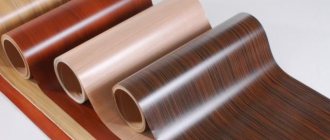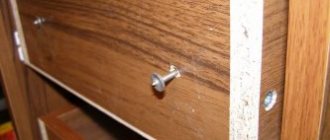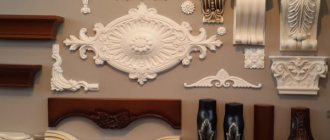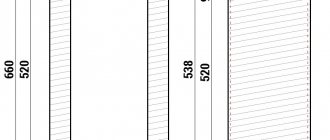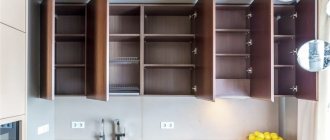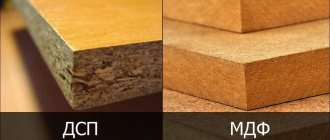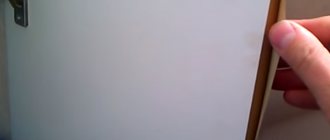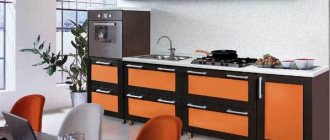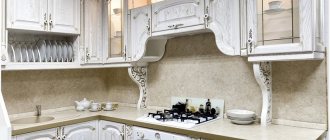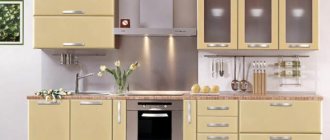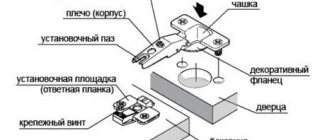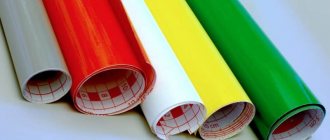Furniture kitchen fronts can be installed on new sets or used to update old kitchen furniture. This section presents all types of facades that we use. Decor collections are constantly updated, and therefore the full and current range of colors can be viewed in our showrooms.
More information about our kitchen fronts
The Kitchen-Everything factory offers furniture doors made from the following types of materials: Solid oak, laminated chipboard, MDF and Plastic.
You can order facades from us in both standard and non-standard sizes; for reference, the most common sizes are:
- 716mm×296mm
- 716mm×396mm
- 716mm×496mm
- 716mm×596mm
When measuring facades yourself, be sure to take into account the gaps between the doors, for example, if the cabinet has a size of 700x600 mm, the required facade size will be: 696x596 mm -1 piece for a single-leaf version and 696x296 mm -2 pieces for a double-leaf version. The required gap between the doors is 4mm, and from the edge of the door to the edge of the body is 2mm.
You can buy kitchen doors separately from the furniture itself at the prices given in the price list for facades. We remind you that if you want to buy a ready-made kitchen with a complete set, see the main price list of the Kitchen-Everything store. Detailed photos and descriptions of various types of facades are posted below.
Kitchen fronts made of chipboard with a glossy UV varnish coating.
Glossy chipboard facades are made on the basis of “Alternative” varnished boards,
supplied to Russian. High-gloss boards coated with UV varnish are an excellent solution for creating kitchen furniture facades. These facades are highly resistant to damage and have a stable glossy surface throughout their entire service life. As the name implies, UV varnish is applied to a chipboard board (its thickness is 16 mm).
Details about high-gloss chipboard-LAK facades
The ends of the facades can be finished with a two-color 3D edge, or PVC edge, repeating the decor of the facade material.
The cost of kitchen sets with chipboard-LAK facades, of course, is significantly higher than the prices for simple kitchens made of chipboard; strictly speaking, sets coated with UV varnish can already be attributed to the premium segment of furniture, but at the same time, “chipboard-LAK kitchens” turn out to be still noticeably cheaper than the very similar “MDF-LAK kitchens”. To create headset projects in various designs and colors, and instantly calculate the price, as always, we suggest working in our unique online kitchen calculator.
Please take a look at the catalog of decors of UV varnished chipboards, some colors can be successfully combined with each other
in one project.
Attention: the cost of a kitchen with combined facades can be increased by UP TO 20%!
Which solution is better: plastic, PVC or enamel
The answer to this question cannot be unambiguous, since any option has its advantages and disadvantages.
- Enamel is a coating of painted facades that effectively protects them. This is the optimal solution for design styles such as classic and Provence. In texture it resembles glossy ceramic tiles. Such facades of a set are best covered with patina. But their high price is due to complex painting technology and the cost of materials. In addition, washing such a cabinet is not so easy: the doors should be carefully wiped with a damp cloth, but in no case with abrasive agents, like glass, especially if the color of the furniture is ─ white. Even the imitation wood finish hides the smallest scratches, and the white tint demonstrates how carefully the owners treat things.
In the photo - kitchens with MDF facades - enamel - Plastic as a coating for MDF facades is a universal solution. Customer reviews indicate that even a white kitchen cabinet with this finish is practical and easy to clean, since the plastic is not at all afraid of abrasive detergents, and they can even be washed with a stiff brush. The price of such options ─ lower than for painted models, but higher than for those covered with PVC film.
In the photo - an MDF plastic kitchen in an aluminum frame - Film coating remains the most economical option. Its price is lower compared to other methods of finishing facades due to simple gluing technology, although the design of finished products is varied: here there is a film for tiles, with a pattern and photo printing, imitation wood or stone, patina coating (this technology is often found in Provence styles or classic). Kitchen furniture with film facades, as seen in the photo below, can be varied in design. But in general, the quality of the film is, of course, inferior to enamel and denser plastic. Although the problem may be identical: like plastic, the film coating peels off after some time.
In the photo - a kitchen with facades made of film MDF
The protective film can cover not only MDF, but also glass. Then you can choose an interesting design solution to apply photo printing and make the interior and each cabinet original.
Obviously, only the buyer himself can decide which facade finishing is best, depending on factors such as the availability of funds, the style and design of the kitchen, and the features of its care. The most economical doors remain those covered with PVC film.
Kitchen facades made of MDF-Frame.
“MDF-Frame” facades for inexpensive economy-class kitchen furniture are a rectangular frame made of MDF profile with a decorative insert, assembled using special glue and Hoffman dovetail dovetails.
Details about frame facades The inside of the frame is filled with a decorative insert made of 4 mm HDF (high pressure fiberboard) or laminated chipboard 10 mm thick. Corrugated glass with a “Crizet” texture (similar to a waffle towel) is installed in the display facades. For additional gluing and filling of voids, the groove of the frame profile is filled with silicone sealant before installing the insert. The cross-section of the MDF profile has a rectangular or semi-circular shape. The color range of MDF frame facades produced at the Kitchen-Everything factory includes beautiful wood and combined plain textures, which you can see below.
Methods of application
Polymer materials are a very popular finishing option; they provide neat facade decor and protection from many external factors. According to the method of application, PVC coatings are divided into the following types:
- Membrane-vacuum. The equipment used is a vacuum press, most often used for countertops, doors between rooms, cabinets, chests of drawers, bookshelves. Thickness - from a quarter to half a millimeter.
- Laminating. The process of gluing or pressing together two surfaces is called laminating. It is carried out using special equipment. It is used for various surfaces made of fiberboard and MDF, including window sills. The thickness of the cladding usually does not exceed three tenths of a millimeter.
- For lamination. Cladding is done on a machine because work is usually carried out on fairly long elements made of metal, plastic or wood in order to protect them from water and give them strength. Two-layer PVC film provides more complete protection from influences, including sun rays.
- Transparent. This type of material is very thin, almost like food grade, it does not perform its functions for too long, but it stretches well, and it is convenient to completely cover the product. Usually it is chosen for transporting something, securing it to the surface of the cargo with glue that does not leave any traces behind.
- For chipboard and MDF. Intended for individual parts, for example, ends. A special machine is used to stretch it, so it is difficult for a beginner to achieve good quality at home, although some craftsmen try to do this, using, for example, a hair dryer.
Ways to decorate furniture with your own hands, useful tips
Film can be applied to surfaces in different ways:
- Laminating. This process has several subspecies, differing in temperature. Smooth elements are processed using the cold method, glue is applied to them, and then the coating is rolled under pressure. During warm processing, the glue is preheated to melt off excess water. The hot type of finishing is carried out at a temperature of 120-160 degrees, using heated rolling rollers.
- Lamination. In this case, no glue is used; the fastening effect is exerted by heat and pressure, which make the substance plastic. The result is a solid, non-delaminating fabric. Waste material is subject to recycling and reuse.
- Post-formation. The most effective option. The layered coating is applied to a base coated with glue on a positioning machine. The press used has a relief that gives the finished product an interesting texture.
Glossy PVC film is usually applied using a vacuum method.
Every technology has its limitations. For example, when laminating, it is imperative that the object be smooth, without protruding fragments or nicks. During post-formation, it must withstand the load that the equipment will place on it.
Options for decoupage furniture in Provence style, master classes for beginners
In general, polyvinyl chloride film for furniture facades is easy to use and has many advantages. It not only gives the furniture a glossy and presentable appearance, but also saves it from accidental damage and premature aging, chemical, thermal and other influences.
For chipboard and MDF
Membrane-vacuum
Transparent
Kitchen facades made of plastic.
The plastic facades used by our factory in the production of economy-class kitchen furniture are made using postforming
, the meaning of which lies in a special method of gluing a base made of chipboard or MDF with a sheet of plastic of various colors.
More details about plastic facades for the kitchen A distinctive feature of such facades is the characteristic bend of the edge of the canvas, due to which the furniture door acquires high decorative properties. The plastic coating has a glossy sheen and a visual sensation of pearlescent color depth, the finished canvases for the manufacture of such facades are produced in Italy, at the Kitchen-Everything factory they only cut these panels into blanks and edge the horizontal ends with PVC edging. Available plastic decors are divided into two groups: glossy with deep texture
and
glossy colored plain ones.
In the Kitchen-Everything online store you can buy plastic facades as semi-finished products, or equip them with ready-made models of sets of our production.
Pros and cons of using
PVC film for furniture facades has a number of significant advantages:
- combination of strength with high elasticity, which prevents tearing of the material during use;
- water resistance;
- low thermal conductivity;
- resistance to many chemicals, deformation, heat and cold;
- there is no fading because the material is impervious to ultraviolet radiation, that is, even when exposed to direct sunlight it will not fade;
- favorable cost, especially in comparison with simulated materials - stone, wood, marble;
- high-quality drawings, interesting textures, impressive appearance of films.
Due to its resistance to moisture and heat, PVC can even be used in the interior of a kitchen or bathroom, where other materials would quickly begin to deteriorate.
However, one cannot fail to note the possible disadvantages:
- self-adhesive PVC film may begin to peel off or bubble if it cannot withstand constant changes in temperature, humidity, and direct rays of the sun;
- sometimes it breaks or is accidentally cut with a knife, then the coating cannot be restored or a separate fragment can be replaced without losing aesthetic qualities, everything has to be re-glued.
Main types of furniture profiles, characteristics, application
In order not to spoil the self-adhesive PVC film, it is better not to clean it with abrasive materials (a sponge with soapy water is perfect), not to cut anything on it with sharp objects, not to expose it to too much heat or cold, or sudden changes temperature. Despite the fact that it must withstand this, its service life will increase significantly if these simple rules are followed.
